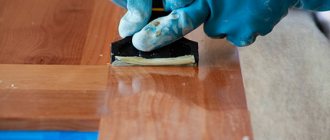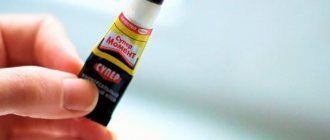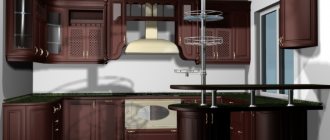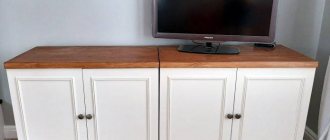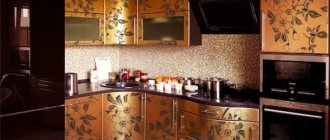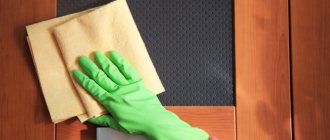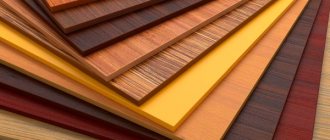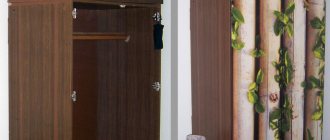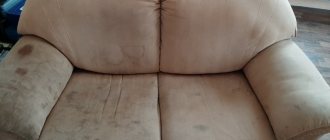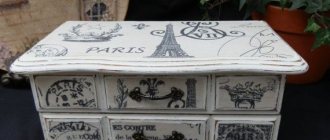- Make mastic from 4 parts melted wax and 3 parts turpentine. This paste is applied to the polish and rubbed with a soft cloth.
If you have shoe polish of a suitable color, you can cover it with it and then polish everything with a cloth.
Scratches are painted over, then the coating is restored
You can simply refresh the faded polish on furniture using mixtures you prepare yourself:
- Two parts each of linseed oil and turpentine and one part vinegar. Mix everything, apply with a swab, wait until it is absorbed and polish.
- Mix oil and beer in equal parts and wipe the furniture with this mixture. After it has been absorbed, rub.
- The surface will be more shiny if you boil beer with a piece of wax, cool it and apply it slightly warm to the furniture. When the composition is absorbed, the surface is rubbed until shiny.
A few more recipes in the video.
How to remove polish from furniture
Quite often you have to remove the polishing: it is not the most fashionable finish. Modern furniture is most often painted with opaque or tinted paints, and the surface is matte. In any case, the polish must be removed. There are several ways. Since varnishes come in different compositions, you have to select them experimentally. But one of the methods should work.
- You can remove old polish from furniture mechanically. If you have a sander, the process will go faster; if not, take coarse-grain sandpaper and remove the varnish layer until wood appears. Then take a fine grit and sand it to a smooth surface. Mechanical removal does not always work. Sometimes even a grinder does not give results: the polish does not come off, but begins to melt and stink. Then they change tactics.
- You will need a piece of old glass. Put on gloves and break it into several fragments. Use the sharp edges that have formed to scrape the coating down to the wood. If there are chamfers and recesses, it is convenient to scrape them out with sharp edges. After the main layer of polishing is removed, everything is brought to a smooth state using fine-grain sandpaper.
Often, restoring furniture with your own hands requires tough measures: some types of polishing can only be scraped off with glass
How to paint polished furniture
If old furniture was prepared for painting, it must be cleaned of dust, wiped with a damp cloth and allowed to dry. Then level everything with putty, smooth out all the unevenness, wait until it dries. Take sandpaper and sand again, first with medium, then with fine grain. Next, apply a layer of primer and wait for it to dry.
Applying varnish with a brush when restoring furniture polish
You buy a primer for the paint you are going to use, or you can dilute the paint with a compatible solvent and coat it instead of primer. After drying, you can paint.
You can paint with a roller or brush. Usually several layers are needed: do not try to apply a lot of paint at once, as drips may appear. It is better to apply several thin layers. This way the surface will be smooth and uniform. Another trick: for uniform coloring, layers are applied in different directions - along, then across. This also applies to applying varnish.
Some types of varnish are easier to work with when they are warm. They are heated a little and then applied with a spray gun or brush. When heating, you need to be careful: vapors may flare up.
In order of painting: first paint the internal surfaces, edges and joints, then move on to the external ones. With this sequence, there is less chance of getting dirty or touching an already painted surface, ruining it.
If the varnish coating is smooth, without defects, and it needs to be painted over, you can do without removing this layer. There are special primers for complex surfaces. Apply them to the surface and paint after drying. They have components that penetrate even the varnish layer. Therefore, the paint will apply well and last a long time. But such soils have a disadvantage: they are expensive. But they save significant time.
Some secrets of painting wood (including brushing and painting in two colors) are in the article “How to paint lining.” Watch the video for a few secrets to applying acrylic paint evenly.
If the restoration does not bring the expected result, maybe you need to change the appearance? How to remake furniture in a new way is described here.
How to restore veneer
Veneered furniture requires a special approach. The means are basically the same, the methods are different. For example, if after getting hit the veneer is swollen, fill a disposable syringe with PVA glue, pierce the bubble, and inject glue into the cavity. Place a piece of thick fabric on top and place a weight. If the surface is uneven (convex or concave), use a thick fabric bag with heated sand as a load.
Such veneer damage is restored in two stages. First, the swelling is eliminated, then the scratch is painted over and the coating is restored.
If the veneer is glued with alcohol glue, you can return the swollen part to its place by ironing it through a rag with a hot iron. But do not overheat the iron: the veneer may stretch. Heating level is medium.
If ironing with a dry cloth does not help, try repeating the operation with a damp cloth (wet it and wring it out well). There is a chance that the wood will swell and become more elastic. To reliably fix the swelling, you can introduce PVA there and then heat it with an iron.
If the swelling is cracked, you can also try to seal it with heating (through a rag). If it doesn’t work, tear off the peeled piece. You don’t cut it, but rather break it off: on veneer, breaks after restoration are less noticeable than cuts. Therefore, you break off the lagging piece. Remove the old glue from the damaged area and the piece of veneer (with sandpaper or a nail file, depending on the size). Next, the repair of veneer on furniture is standard: spread it with PVA glue, lay it down, aligning the fault lines, lay a thick fabric on top and place a weight until it dries.
Such veneer peeling can most likely be eliminated simply by ironing it with an iron.
Scratches and traces of restoration on veneer are removed in the same way as on wood: they are painted over with a furniture marker of a suitable shade. If the scratch is deep, a little melted furniture restoration wax is applied to it (with a spatula). After drying, the wax is ground, and if necessary, fine-grain sandpaper is used, but after this treatment, the restored piece is covered with a layer of varnish.
Do-it-yourself furniture restoration requires patience and accuracy. You have to act gradually and methodically: smear it, wait for it to dry, level it, smear it again, etc. Sometimes you have to try several methods: damage varies, as do the materials used in production (glue, varnish, etc.). But as a result, the furniture will look much better.
Selecting Tools
To remove nail polish you need the following tools:
- polyethylene film;
- hair dryer, which is used specifically in the construction industry;
- blowtorch;
- hard metal brush;
- soft sponge;
- brush;
- respirator along with a mask for protection;
- a special chemical composition that washes away everything;
- glasses;
- rubber gloves;
- sandpaper;
- sanding paper.
How to remove varnish from old furniture
Time to read:
Restoring old furniture is a fascinating and creative process, despite the numerous routine and physical work. How to remove varnish from furniture? Home craftsmen and professional craftsmen share secrets.
Today lacquered furniture is very popular.
- Is it possible to remove old varnish from furniture? Surface preparation
- Selecting Tools
- Chemical
Existing removal methods
Regardless of the method chosen, it is important that the work is completed quickly but carefully.
Here are some of the most common options for those who want to understand how to remove varnish from furniture:
Chemical
This is an effective solution for carrying out the procedure at home.
It is important not to forget about a cotton suit, which will protect the outer layers of the skin from the penetration of active substances. A mask, goggles, and rubber gloves are also mandatory requirements for those who plan to remove old material.
The furniture complex itself for chemically removing varnish is called a remover. It is usually produced in the form of a special powder or mixture that corrodes paint coatings of ten or more layers. Varnish remover is easily purchased in specialized stores.
The stages of removing varnish from furniture can be described as follows.
- The first is preparation. He assumes that, according to the instructions, the powders are diluted with a certain amount of water. To obtain a thick and uniform consistency, all components included in the composition are diluted with each other. Gel compositions adhere easily to surfaces, even vertical ones. By removing it, you also don’t have to worry about the result.
- Wash. A paste-like substance is applied to the furniture. A key step in the process. For application it is recommended to use a regular brush. The surface is treated in thick layers. The movements are carried out in one direction, then there is no need to re-process the surface.
- Next comes the application of special films. This step is necessary to enhance the effect of the wash. To do this, take a polyethylene film and cover the treated surface with it. The film should be left in this place for no more than 1 hour. But it is better to leave the entire structure for 3-4 hours. The quality of the varnish itself and the thickness of the coating from it determine exactly how much time needs to be spent in a particular case. The film is removed when the stage is completed. We get a perfect polished surface. You need to remove the film after a dark brown tint appears. The paintwork itself swells at this moment.
- Next we move on to removing the varnish. If the previous steps were done correctly, then this moment will not cause any trouble. Just take a spatula and get rid of the remaining particles of material. Next, take sandpaper and pass it over the wood base several times. This allows you to remove parts of the material that remain after previous processing. Removing polish from furniture is not that difficult.
It is advisable to use a spatula that does not have sharp edges. If the instrument is new, it is recommended to sharpen it. Otherwise, the furniture itself will be damaged and require cleaning. Plastic tools are best suited for this job.
Finally, all that remains is to eliminate the wash. In this case, we will need at least 0.5 liters of ordinary water. Dissolve vinegar in it, in an amount of 100-150 milliliters. Dip the sponge into the resulting solution, and then rinse the entire surface. Wipe everything dry with a flannel rag. When the furniture is thoroughly cleaned, it is exposed to fresh air. We have already figured out how to remove residues.
In the video: using a remover to remove varnish.
Removing polishing, filling and priming furniture before its restoration
Before you start restoring old furniture, you need to remove the old polish, putty and prime the surface.
When starting to work with paints and varnishes, be sure to ventilate the room. Make sure you have a mask or respirator, rubber gloves, and eye protection in advance.
So, what aids will be needed:
- respirator,
- thick rubber gloves,
- newspapers, rags, rags,
- container with a wide neck,
- mineral spirits.
What else is needed to remove polish from furniture:
- sandpaper,
- metal wool,
- paper towels,
- putty knife,
- an old brush, preferably with natural bristles.
And most importantly, you need a special composition for removing polish . There are thick and liquid formulations. Thick compounds are more suitable for vertical surfaces. And liquid ones are for processing carved parts and hard-to-reach corners. In addition, they are used to apply the last layer of the composition.
To begin with, we will tell you how to remove old polish using a thick binder .
- Pour the binder (a little) into a container with a wide neck (you can take an old mug). Apply the composition with a brush in one direction to an area of approximately 50 by 50 cm.
- Then wait for the coating to soften (this time should be indicated on the packaging of the product). Please note that the composition is effective while it is wet. Typically, one layer of coating can be removed at a time.
- Then scrape off the coating in the direction of the wood fibers using a spatula. So you repeat all the operations until the natural wood appears. By the way, an old toothbrush will come in handy to remove the coating in inconvenient places.
- After this, take steel wool and wipe the furniture with it in order to remove any remaining coating and adhesive. If this was not enough, then you need to apply a thin layer of adhesive using steel wool.
- Then wipe the surface with a paper towel and let it dry. If there is a need and you need to correct the imperfections of the wood or remove traces of old paint and stain, then you need to treat the wood with coarse sandpaper.
- Finally, the surface of the restored furniture must be cleaned with fine-grain sandpaper and wiped with a rag.
How to remove old polish using a liquid compound ?
Pour a little mixture into the container. Dip steel wool there and squeeze out excess liquid. After this, rub the composition on a small area of the surface in a circular motion. This way the old coating will dissolve and be absorbed by the cotton wool. Repeat these steps until the surface is completely clean.
Remove the remaining coating and various stains using a clean compound and fresh cotton wool. Continue these steps until the furniture is perfectly aligned and shiny.
I would like to especially note that we have provided general recommendations for removing old polish. Of course, you need to read the instructions for use of each product to remove old coating from furniture.
Before applying a new decorative coating, the surface of the furniture must be puttied and primed.
Thanks to puttying, defects from the old surface are eliminated: various cracks and pits. You can use ready-made putties for wooden products, or you can use casein or wood glue, drying oils, varnishes and other products.
The putty is applied to the furniture to be restored using a spatula. In this case, tilt the spatula strongly and move it across the wood fibers or at an angle to them. Then remove the excess: place the spatula almost vertically and move it at an angle in the direction of the wood fibers. The surface dries for 24 hours, and then it can be sanded with sandpaper. It happens that the ideal surface is not obtained immediately. Then putty it again. To do this, dilute the mixture to the consistency of cream.
Main problems with lacquered furniture
Such home furnishings acquire their characteristic shine due to the fact that during the production process the wood is coated with special compounds containing resins and varnishes.
Due to these features, furniture:
- quickly absorbs various contaminants;
- prone to the formation of microcracks and chips;
- accumulates static electricity, which attracts dust.
Polished furniture has strict maintenance requirements. Such items should not be placed in rooms with high humidity levels or in places exposed to direct sunlight.
Lacquered surfaces do not tolerate temperature changes and exposure to abrasive particles. In both cases, cracks appear.
After cleaning the varnished surface with a damp cloth, stains remain, and the dry material electrifies the material, thereby facilitating the settling of dust.
How to wipe furniture to make it shine
Over time, the polished surface of furniture loses its glossy shine. This is due to direct sunlight and improper care of the varnish coating. Manufacturers of household chemicals produce products that restore the mirror shine of polished home fittings. The composition includes various waxes and antistatic agents.
Furniture will shine if you clean it with a homemade polish. The basis of such a preparation is any vegetable oil. Turpentine is added to it in a ratio of 1:1 or kerosene, for 1 part oil - 5 parts kerosene.
Mix 1 tbsp. l. any shampoo and liquid antistatic agent, pour 8 tbsp into the resulting mixture. l. water. The resulting solution will thoroughly clean polished surfaces from dirt and prevent dust from quickly settling on bedside tables and cabinets.
Do not clean the varnished surface at home with aggressive substances: alcohol, acetone, acids, alkalis. Avoid abrasive powder products. Caring for polished, shiny furniture should be gentle. Compliance with all the rules will provide lacquered interior items with a luxurious appearance and extend their service life.
What might you need?
You can clean varnished surfaces using:
- soft cloth;
- cotton swabs;
- leather (it is recommended to take soft and thin skin);
- a brush with soft bristles.
To clean polished home furnishings, you will need not only cleaning products, but also a knife to remove serious stains.
Soft flannel or cotton cloth
Flannel and cotton fabric practically do not electrify varnished wood and do not leave streaks. Therefore, it is often recommended to wipe furniture with this material.
Cotton swabs
Cotton wool is used to clean stubborn stains.
Pieces of soft leather
Soft leather is recommended to be used to add shine after cleaning from dirt.
Soft brush
This brush is used to remove stubborn stains. After polishing with such products, no scratches remain.
Water containers
When cleaning furniture, you will need any containers with a wide neck: buckets, pans, or others.
Knife for removing serious stains
The knife is used only in cases where other cleaning methods have failed.
Cleaning methods at home
To remove stains from a varnished surface, household chemicals and folk remedies are used. The latter often allow you to achieve a more pronounced effect.
To remove traces of dirt, you will need to mix malt beer and wax. This composition must be boiled to remove the alcohol.
Then you can rub the furniture with the resulting solution. Beer can remove various types of dirt, and wax will return the varnished surface to its original color.
Special solution
A mixture of shampoo, water and antistatic agent, taken in equal proportions, helps to remove stubborn dirt and grease from polished furniture with your own hands. The latter prevents dust from settling on the surface.
Olive oil and wine vinegar
To clean furniture, you need to mix both components in equal proportions and wash the varnished surface. Wine vinegar can cope with various types of stains. At the same time, the liquid disinfects the surface being treated. Olive oil is used to restore shine.
Burr oil
To remove dirty stains, just apply this oil to problem areas and after 5-7 minutes wipe the surface with a dry material.
Tea brewing
Welding is used both to remove dirt and to strengthen polished wood.
Turpentine, vinegar and flax oil
You can clean contaminated furniture with a mixture of 50 milliliters of linseed oil and turpentine with the addition of 25 milliliters of vinegar essence. In this composition you need to dip a piece of cotton wool and quickly wipe the problem areas.
Sauerkraut brine
To get rid of traces of dirt, just soak a piece of cloth in an acidic solution of sauerkraut and rinse the problem areas, and then clean the surface with a dry cloth. After this procedure, you should also treat the furniture with flannel.
Effective polishes
The use of polishes eliminates the need to prepare cleaning compounds. In addition, cleaning furniture with household chemicals reduces the likelihood of scratches or other defects resulting from poor proportions.
Pronto
This polish is one of the most popular. Simply apply the product to the problem surface and wipe with a dry cloth.
Chirton
Also refers to popular polishes. Chiron contains wax, thanks to which, after treatment, the surface restores its former shine.
Emsal
Emsal has a soft effect on the processed material and hides minor scratches. The polish does not contain wax or silicone.
Luxus
Luxus does not dry out the surface of lacquered furniture, and after treatment creates an additional protective layer.
Mebelux
In terms of the effect it has on polished furniture, Mebelux is no different from Luxus.
Cinderella
A popular Russian polish that removes traces of grease and dirt, while simultaneously removing static electricity.
Fabulous furniture
The polish contains carnauba wax, which masks small cracks and restores shine.
How to remove old varnish from furniture with solvent
To remove varnish from furniture at home, you can use a special varnish remover. Such products have high penetrating power and make it easy and quick to clean the surface.
But furniture can be treated with different varnishes on different bases, so it is necessary to choose a solvent that will not harm the furniture and will allow you to achieve results. But you can only remove varnish using solvents from wooden surfaces.
Before removing old varnish from furniture , you need to prepare the wooden surface of the furniture. First of all, it must be cleaned of contaminants. Over the years, a lot of grease and dirt has accumulated on its surface, which must be removed with ordinary soapy water.
Try to clean all the recesses, nooks and panels. Proceed carefully, the wood should not get too wet, and the soap composition should only clean the contaminated surface and not remove the coating from it.
It is better to treat panels and shaped parts of furniture with special solvents to remove old varnish.
There is no point in talking about how to remove varnish from old chipboard furniture, because... this cannot be done. Together with the varnish layer, the decorative layer that replicates this or that texture will be removed or significantly damaged.
Cleaning complex contaminants
Folk remedies also help to cope with difficult stains. In particular, to clean surfaces, you can sprinkle problem areas with flour and then wipe with vegetable oil.
Traces from hot dishes
To remove such marks, just put a small amount of salt in a cloth, roll up the bag and wipe the furniture. Then the surface must be treated with vegetable oil.
Wax drops
To get rid of the wax, you need to heat the knife and pry out the drops. After this, the problem area is rubbed with gasoline.
Ink stains
A mixture of beer and wax helps get rid of ink stains. This composition does not need to be boiled first. After treating stains, the mixture should be immediately washed off with water.
Heavy soiling
Heated 9% vinegar can remove such stains. You need to moisten a cotton swab in this liquid and then wipe the problem area.
Cleaning away traces of flies
White wine helps with such traces without adding other ingredients.
Unknown origin
To remove any stains, you can use vegetable oil, which should be mixed with ethyl alcohol.
Fat
Traces of fat can be easily removed with leftover tea leaves wrapped in cotton cloth.
Anti-scratch products
Oddly enough, in the kitchen you can also find a number of products that are suitable for restoring furniture with scratches.
Nuts
If you rub a defect with a walnut, it will be almost impossible to notice it. You can also grind the nuts into flour, add a little olive oil, and rub the damaged area. It is better to repeat this procedure once a week.
Using Walnut to Treat Scuffs
Mayonnaise
Fatty mayonnaise can be used to repair scratches on unpolished wood. A drop of the product is placed on the furniture, gently rubbed in, after a day the product is sanded and rubbed with a rag.
Small scratches can be disguised with mayonnaise
Lemon
Lemon is used together with vegetable oil. The juice of this fruit is mixed equally with sunflower or other oil, smeared on the defective area on wooden furniture, and polished with a lint-free cloth.
Making polish from lemon and vegetable oil
Using welding, you can mask small abrasions and shallow scratches. Brew a bag of black tea with a small amount of boiling water and leave for 20 minutes until the liquid becomes rich in color. Then soak a cotton pad in it and apply it to the scratch for a couple of minutes. This method will not work for light-colored furniture.
You can treat scratches on a wooden surface with a tea bag.
Instant coffee
A tablespoon of coffee should be diluted with water to make a thick paste. Place the mixture on the damaged area of the wood product, avoiding contact with other areas. After 5 minutes, remove excess with a cloth.
Coffee grounds for scratches
Vinegar with olive oil
This product is great for light polished furniture. Mix 50 g of oil and a teaspoon of table vinegar. The composition is applied to the abrasion, left for a day, then wiped the area with a rag.
Olive oil and vinegar for scratches
Fish fat
One capsule of fish oil is enough to repair a small defect on a wooden surface. The liquid is rubbed into the damaged area, left for 2 hours, then the greasy mark is removed with a rag.
You can treat scuffs on furniture with fish oil.
Dealing with minor defects
Oil-based products or stains can help remove scratches. But such compositions are not recommended for use in cases where small cracks have appeared on the surface. To remove such defects, use wax, shoe polish or walnut.
Wax crayon
To hide a scratch, you need to melt wax in a water bath and treat the problem areas with the resulting composition, wiping these areas.
Shoe polish
Shoe polish must be matched to the tone of the surface being treated. The substances included in this product fill microcracks and thereby eliminate defects.
Walnut
Use the nut kernel to rub the problem areas with light pressure. The oil released during the procedure will fill the defects.
Reasons for contamination of polished objects
As with any furniture, the main reason is dust settling on smooth tables, cabinets and bedside tables. But varnished surfaces not treated with antistatic agents have an increased ability to “attract” the smallest particles. Microcracks in the smooth layer also accumulate contaminants, which are difficult to remove. Therefore, the fight against dust on polished furniture is especially important.
Additional causes of pollution are:
- greasy fingerprints left after touching the polish;
- stains from any spilled liquid;
- stains from wet wiping of furniture that were not removed in time by additional polishing;
- stuck pieces of paraffin, wax or plasticine;
- traces from the impact of hot objects placed on the surface without gaskets.
In addition to dust, most pollution is created by one’s own hands as a result of negligence when handling furniture. You can avoid them by following simple rules. But we cannot rule out chance.
If stains do appear on polished furniture, you need to be able to remove them correctly without causing additional harm.
Recommendations
Leading furniture manufacturers claim that it is easier to protect their products from damage in a timely manner than to restore them, and recommend:
- Use protective accessories. This is especially true for wooden countertops. Tablecloths, cutting boards, and hot pads minimize the risk of mechanical damage.
- Remove excess moisture. Wood can become deformed when exposed to water.
- Use only soft sponges and rags without an abrasive layer for cleaning. They leave micro-scratches on furniture, which will become a big problem over time.
- Choose only care products intended for this material. Compositions with aggressive and abrasive components are strictly not recommended.
If you are interested in how to remove small and deep scratches from various surfaces and objects, take a look at this section.
Safe cleaning tools
When processing polished furniture, it is easy not only to remove dirt, but also to damage the varnish layer. Therefore, it is unacceptable to use any harsh objects - scrapers, coarse bristles, abrasive sponges.
- cotton and flannel fabrics;
- suede cuts;
- cotton pads and tampons;
- pieces of soft leather;
- light brushes to sweep away dust.
To remove stuck-on dirt, you will need a table knife or a metal spatula.
It is advisable not to clean the surface of the furniture directly with sharp objects, but first slightly heat the metal over a fire or in boiling water. After this, the wax or paraffin will be easier to remove from the polish.
Safe chemicals for cleaning polished furniture
The coating is sensitive to mechanical stress and is not resistant to many solvents and cleaning agents. Therefore, when choosing an industrial product, you must definitely look at the possibility of using it for polished surfaces.
It is unacceptable to clean lacquered furniture with any construction solvents - acetone, white spirit, gasoline. They will inevitably damage the polishing layer, making it cloudy.
Any cleaning requires subsequent treatment to restore and improve the smooth surface. Therefore, when purchasing products for the care of polished furniture, it is advisable to choose cleaners that also have polishing properties.
It is recommended to start using a new product by treating a small, inconspicuous area on the surface. This will avoid unpleasant consequences and damage.
Features of caring for polished home furniture
Natural wood is a good material for cabinets, tables, and chests of drawers. To make its service life longer, the interior item is varnished. On such a headset, fingerprints, cracks, and scratches are clearly visible and need to be cleaned. To ensure that caring for polished furniture at home does not cause much trouble, follow these tips:
- Polished cabinets, tables, chests of drawers are made of wood that is sensitive to the level of humidity in the premises. An excessively dry microclimate contributes to cracking of the wood base; excess moisture causes swelling of the fibers. As a result, the varnish coating is destroyed, which will be more difficult to clean. To preserve your home furniture for many years, place it away from heating appliances, sunlight, and protect it from water.
- Lacquered coatings do not like temperature changes - the cold will cause the varnish layer to be dotted with a network of small cracks, and hot cups will leave persistent whitish marks on the tables that need to be cleaned immediately.
- A damp cloth leaves stains on polished home furniture, and when wiped with a dry cloth, the surface becomes electrified and begins to attract tiny particles from the air. Dust settles regularly - you will have to clean and wipe down cabinets at home often.
- A thick layer of varnish is incredibly fragile. Even minor mechanical impacts can cause deep scratches or cracks.
Folk remedies for cleaning furniture
You can clean any polished furniture at home using numerous substances and liquids used in the household. For complex cases, there are recipes for safe but effective mixtures and solutions from several components.
Some of them are used only to remove dirt, but there are also compositions that allow you to polish the cleaned area, giving it its original shine.
For fresh stains
To remove fingerprints and newly appeared traces of fat, use:
- Talcum powder or baby powder . Apply the powder to a cotton pad and wipe the stained area. On horizontal surfaces, it is better to simply sprinkle the dirt, wait 5-10 minutes and only then wipe. Remove any remaining talc with a dry cloth or soft brush.
- Raw potatoes . An old but proven remedy. It does not need to be poured or spread on anything. Rub half of the tuber onto the problem area. For best results, wait 3–15 minutes. After this, polish the rubbed area with a flannel cloth.
- Milk . This product is able to clean off light stains and at the same time restore the shine of the polishing layer. Use a soft cloth soaked in milk to walk over the stained area, and rub any remaining liquid with dry suede.
It is best to remove polish stains with a mild soap solution. Of course, you shouldn’t pour it on the surface of the furniture. Use a soft cloth lightly dampened with soap and water.
After wiping with any composition, be sure to immediately go over the cleaned area with polish or simply rub thoroughly with a flannel.
For strong and old stains
If long-formed marks are noticed on polished furniture that spoil its appearance, it is better to use more complex means and compositions to remove them:
- Sauerkraut . A piece of soft leather is soaked in brine, and then any traces of dirt found are wiped off.
- Tea brewing . To clean polished surfaces, you don’t need to prepare it specially – you just need old remnants of used tea. They are wrung out and placed in a paper napkin or fabric bag. The resulting swab is used to wipe away dirt, followed by treatment with flannel.
- Beer . The drink is suitable for cleaning and polishing. It is preheated until it begins to boil. After waiting for complete cooling, apply to the contaminated surface. After drying, the resulting thin layer is removed with soft cloths and polished.
Cleaning stained furniture is half the battle. Any removal of dirt and greasy marks should be completed by treating the cleaned area with compounds to restore its shine.
How to clean polished furniture at home
Cleaning polished furniture is done using special products or available home remedies. The main point of care is dust removal.
Main types of store compositions:
- products that remove dust and reduce electrification from furniture;
- Oil-based polishes add shine;
- In addition to cleaning, products with waxes form a protective film that protects against moisture and other unfavorable factors.
From fingerprints
Our skin contains many sebaceous ducts. Fingerprints on polished beautiful furniture most often have a fatty base. To clean horizontal table tops or chests of drawers, you need to sprinkle a thin layer of talcum powder on the stains. Then the surface must be wiped with a dry soft cloth. Vertical cabinet doors can be easily cleaned of fingerprints with half a cut raw potato.
From traces of hot dishes
Whitish circles from hot objects can be removed at home in several ways:
- You can apply Vaseline to the stain, leave it for 2-3 hours, and clean the problem area on a polished table or shelf with a flannel or a piece of suede.
- Mix table salt with vegetable oil and apply to the print. After 2-3 hours, remove the remaining mixture from the furniture and clean the treated area with a woolen cloth.
- The whitish mark is rubbed with a piece of paraffin candle, covered with a cotton cloth, and ironed with a warm iron.
Instead of cleaning stains on a polished surface, it is better to prevent such marks from appearing by covering tables with tablecloths, napkins, or bamboo coasters.
Oily stains
Dining tables and kitchen cabinet fronts often get dirty. A fresh stain is covered with flour, then wiped with a cotton pad soaked in vegetable oil. Old fat is more difficult to clean off at home. Mix baking soda with any oil: olive, burdock, sunflower. Apply the paste to the contaminated area, then rub the cleaned area with a soft cloth.
A concentrated soap solution has good degreasing properties. To clean a polished furniture set, grate a piece of laundry soap, dissolve it in warm water, add a few drops of liquid dishwashing detergent. Dampen a cloth and clean problem areas. An alternative method is to lather a slightly damp cloth and wipe the oily areas.
Difficult spots
Sometimes stains appear on polished home furniture, the origin of which is unknown, but they are difficult to remove. One of the effective means for cleaning polished shiny furniture at home is kerosene. It cleans wonderfully and adds shine to the varnish coating. After using kerosene, the room must be thoroughly ventilated.
An ammonia aqueous solution can help clean severe stains at home: mix 10 ml of ammonia with 50 ml of water. Dampen the sponge and clean the stained areas.
Sticky tape marks on polished, beautiful furniture can be removed with undiluted dishwashing detergent, citrus essential oil, or a regular school eraser. The adhesive tape is rubbed off slowly, and you should not use extra force to avoid leaving scratches on the varnish. In difficult cases, try cleaning sticky marks with nail polish remover that does not contain acetone. First, test how the chemical works in an inconspicuous area. Traces of brilliant green, ink or children's markers can be easily cleaned with warmed beer.
Polishing agents
It is necessary to renew the smooth layer on the surface of the furniture regularly, and after exposure to any cleaning agents, it is imperative.
For this purpose, in addition to industrially produced polishes, you can also use homemade compositions from household substances:
- Burr oil . Plant extract is best suited for polishing furniture without adding additional components. Using a cotton swab soaked in the composition, wipe the entire surface with little effort.
- Vegetable oil with vinegar . This mixture is prepared by mixing the components in equal volumetric proportions. Then apply to polish and rub.
- Beer . A piece of wax or paraffin is added to the beer being heated for cleaning. After cooling, a composition is obtained that can clean off dirt and simultaneously polish the same area.
In more advanced cases, a complex restorative mixture will help. It is prepared by mixing turpentine, linseed oil and vinegar in a volume ratio of 2:2:1. Before use, shake the composition vigorously and apply the resulting emulsion to the area with the damaged varnish layer.
All polishing agents are rubbed in a circular motion. It is not recommended to use sponges and brushes. The best tool is flannel or suede.
How to deal with polish stains
When polishing, a thin protective film is formed on the surface of cabinets and tables, but if the furniture is actively used, it quickly wears off. You can cope with marks from fingers, cups, and water using simple improvised means.
- traces of drops are removed with a sponge soaked in a soap solution. After this, the furniture must be wiped dry immediately;
- fingerprints and palm prints can be removed with half a raw potato;
- Also, greasy fingerprints can be easily removed by adding a little talcum powder to a cotton pad and wiping the stains;
- complex contaminants of unknown origin are removed with a mixture of vegetable oil and medical alcohol. You need to rub carefully so as not to damage the polishing layer. After removing the stain, the furniture is immediately wiped, first with a clean damp cloth and then with a dry one;
- marks from cups of hot tea or coffee can be removed with regular salt. The salt is wrapped in a piece of cotton cloth, dipped in vegetable oil and the marks are processed in a circular motion. After this, there is no need to wipe the surface with a damp cloth, it is simply polished to a shine;
- stains from paint, ink, brilliant green, or any substance with a coloring pigment can be removed with heated beer. It is applied to dirt and left until dry, then wiped with a piece of wax and polished;
- if drops of wax or paraffin or a candle get on the polished table, then they are first carefully removed with a sharp, hot knife, and the mark is removed with a cotton swab dipped in gasoline;
- Any stains on polished furniture can be removed using sauerkraut brine. A piece of skin is soaked in it and the dirt is gently wiped away. After this, the polish should be rubbed with a dry cloth.
